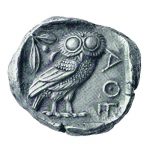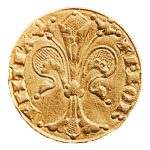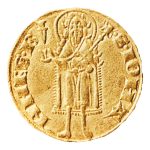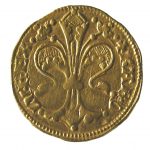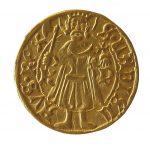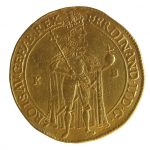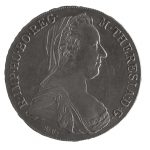On the first floor, visitors have a unique chance to see a full history of money in the territory of Slovakia from the earliest times to the present, with a particular focus on production at the Kremnica mint. It shows not only coins but also the technology used to mint them from medieval times to the present, alongside various trial strikes and coining tools.
The exhibition begins with the diverse forms that money could take before the introduction of coins and the first coins struck in the territory of Slovakia, which were made by the Celts in the first century BCE. These are followed by Roman, Byzantine and Western-European (Carolingian) coins that have been found in our territory dating from the beginning of the current era to the 10th century. Although the Great Moravian Empire did not mint money of its own, finds of coins from closer and more distant neighbours indicate a flourishing of trade. Later the territory of Slovakia became part of the medieval Kingdom of Hungary. This period is documented by the numerous mintages of small dinars, high-quality silver groschens and the world famous Kremnica florins, later known as ducats.
The earliest coins were struck manually on a block using a coining die and a hammer, and this method remained in use until the 17th century. From this date mechanical striking gradually took over. At Kremnica, a roller minting machine operated from 1661 and a screw coin press, or balancier, was introduced in 1710. Since the 19th century, the mint has used automated minting machines.
The first room concludes with a presentation of the famous Kremnica guldiners, heavy silver coins minted at the turn of the 15th and 16th centuries.
The next room exhibits the diverse circulation coins of the multinational Habsburg monarchy and presents the attempts made to develop a single currency. The history of paper money in the Kingdom of Hungary began in 1762. In this part of the exhibition, visitors can see the oldest banknotes of the Habsburg monarchy, monetary inflation from the time of the Napoleonic Wars, paper money issued during the Hungarian Revolution of 1848-49, banknotes of the Austro-Hungarian Bank and the first Czechoslovak banknotes. There are also souvenirs of the more recent past in the form of post-1948 banknotes and coins. Amongst the most interesting exhibits are numerous trial strikes and coins that never entered production. The establishment of the Slovak currency in 1993 is documented in detail – from stamped Czechoslovak banknotes through the artistic design of the coinage to the final form of the Slovak koruna. The exhibition ends with a reflection on the introduction of the common European currency – the euro – in 2009.
What types of money have been used in our territory?
In the depths of prehistory – money before coins
In the earliest period of human society, trade took simple and somewhat haphazard forms. There was trade in a wide range of natural products such as stones – flint, hornblende, claystone, obsidian – and tools made from them, shells, cattle, later bronze and iron tools and functional objects. As the exchange of products intensified, some of them came to be seen as more valuable than others, either because of their material or their function. They became a general equivalent, a measure of value, against which the value of the other items could be compared. Precious metals, especially gold and silver, eventually became dominant.
On the threshold of written history – the Celts (4th to 1st century BCE)
The first coins as we would recognise them today appeared in the mid-7th century in Lydia in Asia Minor, later spreading through Persia and Greece. The oldest coins found in the territory of Slovakia were made by the Celts in imitation of Greek and Macedonian coins. The diversity and variability of the currently known types of Celtic coins minted or sued in our territory is documented by tetradrachms of the Ptíčie and Veľký Bysterec types, the Bratislava hexadrachms (known as biatecs), gold staters, small coins with horse motifs. A find of tetradrachms of the Veľký Bysterec type in Turiec included the oldest known Celtic coining die in Slovakia. Finds of crucibles and moulds document the activity of a Celtic mint at Bratislava in the 1st century BCE. The Celtic inscriptions on the biatec coins – AINORIX, BIATEC, BVSV, BVSSVMARVS, COBROVOMARVS, COISA, DEVIL, IANTVMARVS, FARIARIX, MACCIVS, NONNOS, TITTO – represent the oldest known use of the Latin alphabet on our territory.
On the borders of the Roman world – Romans and Germanic peoples (1st to 4th centuries)
The situation in Slovakia changed greatly as the Roman Empire pushed its borders to the banks of the River Danube. A line of fortified camps and trading posts, the Limes Romanus, was established on the river’s left bank. Important military and commercial contacts took place across this border. As a result, various types of Roman coin came into our territory (the oldest cast copper coins – aes grave, denarius coins of the Roman Republic, the rich system of gold, silver and copper imperial coins). A rare find is an antonianus overstruck on an earlier silver denarius. The coin shows Regalianus – a usurper of the Roman Empire who was acclaimed and then murdered by his own troop in just a few days (around 260 CE).
Times of change – the migration period, Slavs, Avars and Byzantines (5th to 8th centuries)
Byzantine mints continued the traditions of the Romans. The Byzantine gold solidus became the generally accepted currency of international trade. Its name comes from the Latin word “solidus”, which means “massive, solid, enduring”. The coin preserved its high weight and purity of metal until the fall of the Byzantine Empire. The Slavs and Avars did not mint coins and preferred to use items from nature or barter. Coins were used as a raw material in the craft workshops operated by itinerant Byzantine smiths. Evidence of this can be seen in the 7th century treasure found at Zemiansky Vrbovok in Krupina District.
Great Moravia – rise and fall (9th and 10th centuries)
Thanks to foreign political and economic contacts, Great Moravia began to use foreign coins, mainly later Roman, Byzantine and Frankish coins. They did not function as a full currency but tended to be used for local payments, counting or decoration. Domestic functions of money were performed by iron formed into bowl-shaped discs (known as “Silesian bowls”) and flat iron axe-shaped ingots with a punched eye at the tapered end, generally known as “Great Moravian hryvnias”. The widespread use of such hryvnias is documented by numerous archaeological finds, mainly in the Central Považie region. The largest find was at a hillfort near Pobedim.
The denar period
When the Kingdom of Hungary was established, the first coins minted by a ruler were the denars of King Stephen I. The silver-based currency aligned with the coinage system established by the Frankish emperor Charlemagne. The direct model was Bavarian coins. From a unit weight of 1 pound, up to 510 half-denar (obulus) coins were struck. The coins were relatively light, but the good quality silver resulted in large-scale exports to Scandinavia, the Baltic, Germany, Bohemia and Moravia. In addition to mints at Esztergom and Buda, there was briefly a mint at Bratislava (PRESLAVA CIV). The appanage dukes of Nitra, Belo and Gejza, minted their own coins in their lands. There was a devaluation at the beginning of the 12th century. Coins were reduced so much in size and weight that the denar’s parameters were practically a quarter of their original values. King Bela III (1172 – 1196) implemented a currency reform to deal with this. He introduced larger copper coins based on Arab and Byzantine models and small, one-sided, embossed coins from thin silver sheet – bracteates. In the 13th century, trade between merchants was conducted mainly with Friesach and Viennese Pfennigs and Slavonian Banal denars. When there were shortages of coins, payments would be made using pieces of silver in the form of bars, rods or unstruck coin planchets (discs). Several counterfeiting workshops have also been found (e.g., Krupina, Zvolen – Pustý hrad Castle).
The groschen period
When Charles Robert of Anjou took the Hungarian throne (1308 – 1342), there was a change of monetary policy. With the help of Lombard bankers and the Czech king John of Luxembourg, he carried out important economic reforms focussing especially on mining and currency. In 1328, Kremnica was granted town privileges and the mint was established here. In 1329, It began producing a new silver coin modelled on Czech groschens – the Hungarian groschen. From 1325 at Buda and from the 1330s at Kremnica, Charles Robert began minting coins modelled on Florentine gold coins. They were known as Hungarian florins, later as ducats. During the reign of Sigismund of Luxembourg (1387 – 1437), Hussite (later Bohemian Brethren) raids into Hungary and the need to fund the ruler’s foreign ambitions provoked an economic crisis and devaluation. An enormous quantity of low-quality silver-plated or entirely copper coins were minted with negligible value – quartings, parvus coins, small silver ducats. The political and economic situation improved during the reign of Matthias Corvinus (1458 – 1490) who suppressed the last incursions of the Bohemian Brethren and created a strong, centralised government through reforms of the administration, judiciary and army. Coins were minted with a year from 1503.
During the reign of Vladislaus II (1490 – 1516), the Hungarian authorities made their first attempts to introduce large silver coins known as guldiners, the direct precursors of thalers. They were struck at the Kremnica Mint from 1499 to 1506 on instructions of Ján Turzo, the head of the mining and metallurgy chamber.
Thalers
From the 16th century the thaler, a large and heavy silver coin, became popular all over Europe. The main model for the Czech lands and Hungary were silver coins from Saxony known as guldengroschen. The Counts of Schlick minted silver coins based on them at their Joachimsthal Mint (now Jáchymov in the Czech Republic) in 1519/1520. They were initially known as Joachimstalergulden (guldiners from the St Joachim valley – “tal” being the German word for valley). They became popular in Central European trade, even taking the place of gold coins. “Thaler” became the generic name for a large silver coin with a high face value and is the root of the English word “dollar”. They were first struck in Hungary in 1553. The Kremnica Mint continued to produce ducats of traditional quality alongside thalers and small coins of a high standard – denars, obuluses and groschen worth 4 denars. Hungarian thalers kept up a high level of quality through the 16th and 17th centuries. Together with ducats, they were used mainly to finance government debt, war and expenses of the royal court. Smaller and smaller amounts of silver were used in the production of petty currency, whose weight and quality decreased sharply. An immense number of coins were produced that were not backed by stocks of precious metal. The Košice and Bratislava Mints were temporarily reopened. A serious problem was the export of Hungarian coins abroad and their replacement by low-value currency, especially from Poland. The Polish poltorak (worth 1.5 groschens) gradually entered domestic circulation despite many attempts to prohibit its import.
The currency reforms of Leopold I
The currency reforms of Leopold I (1657 – 1705) made significant progress in unifying the coinage of the Habsburg lands, though they did not get as far as planned in Hungary. Two new medium-value silver coins were introduced with face values of 15 kreuzers and 6 kreuzers. Groschen, kreuzer and half-kreuzer coins were minted with a lower real value than before and the face value of the 15- and 6-kreuzer coins increased to 17 and 7 kreuzers. In Hungary, two new low-value coins entered circulation – the poltura, equal to 1.5 kreuzers, and the duarius, equal to 0.75 kreuzer. At the end of the 17th century, mints even began producing copper coins, which made the situation of the less wealthy even worse.
The coinage of the “malcontents”
A short but special chapter in the history of money in Hungary must consider the coinage of the “malcontents” who participated in the last anti-Habsburg aristocratic revolt led by Francis II Rákóczi, Prince of Transylvania. The rebel-held territory included nearly all Slovakia and Rákóczi had the government mint produce his coins – ducats, guldiners (half-thalers) and polturas. Most of his coins were copper polturas and multiples of the poltura (four-, ten- and twenty-poltura coins), colloquially called libertás (liberty) coins. They were struck in large volumes and were mainly used for soldiers’ pay. The population did not have much faith in these credit-based coins and refused to accept them even when threatened with punishment. After the rebellion, they quickly went out of circulation.
Convention currency
The reforms of the enlightened monarch Maria Theresa (1740 – 1780) also affected money and currency. Several German states joined her currency system (convention) between 1753 and 1763 and it can be considered a first attempt at monetary union in Central Europe. Within the Habsburg lands, there was a complicated system of coins issued by Maria Theresa, Francis of Lorraine and Joseph II with different illustrations for each of the dynasty’s domains. Alongside ducats and thalers, the mints produced 30-kreuzer, 20-kreuzer, 17-kreuzer (Maria groschens), 15-, 10-, 7-, 6- and 3-kreuzer, poltura, kreuzer and denar coins, as well as ½- and ¼-kreuzer and pfennig coins in the Austrian lands. The low purity, small dimensions and low weight of low-value coins and the difficulty of handling them led to their replacement by copper coins. Although these were larger and heavier, their face value was higher than the value of the metal in. Their circulation depended on confidence in the state, hence they are often referred to as confidence money. They were struck as kreuzers, half-kreuzers, quarter-kreuzers and gröschels.
The rise of paper money
An important reform of Maria Theresa was the decision to issue the first paper money, which was necessitated by a shortage of precious metals and ever-increasing military spending. On 1/7/1762, the Municipal Bank of Vienna (the oldest bank in the Austrian monarchy, founded in 1703) began issuing banknotes called “banco-zettels” with face values of 5, 10, 25, 50 and 100 gulden. They made it much easier to the manage large sums. As the notes were destroyed when they were returned to the bank, many of them are known only from their official issuing decrees. There were further issues of banknotes, including some with higher nominal values, in 1771, 1784 and 1800. Due to a shortage of petty currency, banknotes with nominal values of 1 and 2 gulden were also issued. Coins were struck with a lower silver content than their nominal value.
The counterfeiting of “banco-zettel” notes began almost immediately, undeterred by security features such as dry stamps (embossing), a complex watermark and variable sloping of the letters. Napoleon’s armies were known counterfeiters. When they occupied Vienna in 1805, the French found the equipment for printing banknotes in the Dominican monastery. Their counterfeits were distinguishable only by the colour of the paper, which was bluish. Napoleon ended the counterfeiting after he married Princess Maria Luisa in 1810.
State bankruptcy in 1811 and the foundation of the Austrian National Bank
After the Napoleonic Wars, the government issued a patent in March 1811 declaring the state bankrupt and reducing the value of paper money and copper coins by 80%. The “banco-zettel” notes were withdrawn from circulation and replaced in a ratio 5:1 with “redemption notes”, colloquially known as “scheins”. From June 1813, the government issued yet another type of money, “anticipation notes”, mainly to cover war costs.
The Privileged Austrian National Bank was established from 1/6/1816 to stabilise the currency. It issued banknotes that could be exchanged for silver coins and withdrew the redemption and anticipation notes from circulations.
The revolution of 1848 – 1849
The revolutionary events of 1848/49 disrupted the currency and the structure of money in circulation. In territory controlled by the Hungarian revolutionaries, four types of paper money circulated alongside coins. There were banknotes issued by the Hungarian Commercial Bank, government notes and interest-bearing notes issued by the Ministry of Finance and cashier notes issued by the Territorial Defence Committee. Austria punished the use of money issued by revolutionaries as high treason. These types of money with no backing in precious metal lost all value after the suppression of the revolution and were even publicly burned on what is now Calvin Square in Budapest.
Austrian currency 1857 – 1892
From 1857, Austria, the German Customs Union and Liechtenstein shared a common currency. Coins circulated in the countries with different images but the same parameters. Countries also issued metal and paper money that was valid only in their own territory.
Austria left its currency union with the German states after losing wars with Italy and Prussia in 1866. The Austro-Hungarian Bank was established in 1878 and took over the function of the single issuing bank. It had two headquarters, in Vienna and Budapest. Unlike coins, banknotes of the Austro-Hungarian Bank had just one form throughout the monarchy. They were not said to have a front and a back but equal Austrian and Hungarian sides.
The Austro-Hungarian krone/korona 1892 – 1918
In the second half of the 19th century, many states based their currencies on a gold standard or gold exchange standard. Austria-Hungary implemented this from 2/8/1892, when it introduced a new currency unit – the krone/korona – divided into 100 hellers/fillers. 1 gulden was equal to 2 kroner. Alongside circulation coins, several commemorative krone/korona editions were struck. Favourable economic development at the turn of the 19th and 20th centuries was terminated by the First World War. The Austro-Hungarian Bank had to finance war expenditure and its gold reserves were depleted. Coins made of gold and non-ferrous metals were hoarded and banknotes were printed without restriction. The Austro-Hungarian Bank launched a new issue of banknotes shortly before the war and continued to replace the old issue during the war. Small silver coins were replaced by banknotes worth 1 or 2 krone/korona.
Establishment of the Czechoslovak currency
After the collapse of the Habsburg monarchy, its successor states continued to use the Austro-Hungarian currency that had been devalued by the war. It retained its value better in the more economically and politically stable Czechoslovak Republic than in the other successor states. Only currency separation could protect its value. From 3 to 12 March 1919, Austro-Hungarian banknotes had to be stamped, and half the banknotes submitted for stamping were temporarily withheld. The currency unit of the Czechoslovak Republic was declared to be the Czechoslovak koruna (Kč), divided into 100 haliers. The exchange rate of the Czechoslovak koruna was always at least twice that of the Austrian and Hungarian krone/korona. Exchange rate differences and the bad quality of the stamps led to mass counterfeiting and importation from abroad. Some of the most famous counterfeits came from the Mészáros workshop, which produced very high-quality counterfeits of the Czechoslovak 500-koruna note in 1919. Responding to the falsification of stamps, the Bank Office of the Ministry of Finance, as the issuing authority of the Czechoslovak Republic, was quick to prepare and issue state banknotes. Most of them were designed by Alphonse Mucha using a style similar to his famous poster art. Counterfeiting of the first issue meant it had to be replaced by a more technically advanced version. On 1/4/1926, the Czechoslovak National Bank began operations and took over the administration of the currency and the issuing of banknotes and coins.
Slovak Republic 1939 – 1945
After the establishment of the Protectorate of Bohemia and Moravia and the proclamation of the Slovak Republic, a government decree with force of law established a new currency – the Slovak koruna – from 4/4/1939. At the start of summer 1939, the Slovak National Bank withdraw high-value Czechoslovak banknotes and replaced them with the same notes stamped SLOVAK STATE. It also began intensive preparations for issuing national banknotes and coins. Most of the Slovak money system was completed in summer 1942. The designs came mainly from anonymous competitions The coins were struck at the Kremnica Mint and paper money was initially printed abroad and from 1943 also at the Neografia printworks in Martin.
Slovakia after the end of the Second World War
From 1944, the Soviet Army’s military vouchers served as money in the liberated territory of Slovakia. In July 1945, the Slovak National Council ordered the stamping of Slovak banknotes and military vouchers with values of 100, 500 and 1,000 crowns.
The currency reform of 31/10/1945 unified the currency of the Slovak lands with the Czech and Moravian lands. Excess notes and coins were withdrawn, and the Czechoslovak koruna became the single currency again. The new currency used paper money printed in England during the war and 100- and 1,000-koruna notes printed in Prague in the summer of 1945. The new coinage was delayed due to damage that the Kremnica Mint suffered at the end of the war. The coins used the same pictures as the pre-war Czechoslovak currency, but they were smaller and used cheaper material (copper-nickel, aluminium). Issues of commemorative coins were also made. The single issuer was the Czechoslovak National Bank.
The currency reform of 1953
Soviet advisors at the Ministry of Finance recommended combining the end of rationing, which had been in force since the end of the war, with a currency reform along the lines of the USSR’s measures in 1947. The reform was approved by President Klement Gottwald on 17/11/1952 and by the Central Committee of the Communist Party of Czechoslovakia and the National Assembly on 30/5/1953. Each person was permitted to receive up to 300 new korunas at a ratio of 1:5 and further sums were exchanged at a ratio of 1 new for 50 old. The paper money was printed by the GOZNAK printworks in Moscow to instructions and documentation provided by the Ministry of Finance in Prague. The first batches of coins were produced at the Leningrad Mint.
Czechoslovak Socialist Republic
The issuing of new banknotes was delayed by the country’s change of name in 1960 and ideological conflicts over the design. Only the coat of arms and the year were changed on coins and banknotes. In the mid-1960s, a more relaxed climate permitted the replacement of the unpopular 3- and 25-koruna notes with 2- and 20-koruna notes. The need for new banknotes became urgent in the mid-1970s because of the lack of protection against black and white photocopy counterfeits. New themes were introduced in the technically and artistically unified series designed by Albín Brunovský. The notes received international acclaim, although at home the colourful design and motifs often met with incomprehension.
Slovak Republic 1993 – 2008
After the dissolution of Czechoslovakia from 1/1/1993, the two newly established states formed a currency union that would operate until they issued their own currencies in summer 1993. In mid-January the governments of the two countries agreed to separate their currencies from 7/2/1993. From 4 to 6 February, citizens of the Slovak Republic could obtain up to SKK 4,000 in stamped banknotes, which became the legal tender on 8 February. The currency separation did not affect coins.
The motifs for the new Slovak coins and banknotes were chosen to represent a cross-section of the history of the territory of Slovakia from the earliest times to the modern age. The banknote series used designs produced by Jozef Bubák in 1991 and the coins were designed by Drahomír Zobek of the design studio of the Kremnica Mint. The banknotes issued by Národná banka Slovenska were among the world leaders in both artistry and security features.
Euro
Having satisfied the entry criteria, Slovakia joined the euro area on 1 January 2009 and adopted the single currency. The first series of Euro banknotes was issued in seven denominations – € 5 €10, €20, €50, €100, €200 and €500, which are legal tender throughout the euro area. Euro notes show motifs of windows and doorways on the front and bridges on the back to symbolise openness and cooperation, based on seven architectural styles from antiquity to the present.
The euro coin series comprises eight different denominations: 1, 2, 5, 10, 20 and 50 cent, €1 and €2. All euro coins have a common side and a national side. The national side indicates the issuing country. You can use any euro coin anywhere in the euro area. The common sides show the European Union or Europe and symbolise the unity of the EU. With the consent of the European Community, the euro is used as the currency of San Marino, Monaco and the Vatican City though they are not members of the euro area.
Every member of the euro area can issue one or two €2 commemorative coins per year, and these become legal tender throughout the euro area. These coins have the same features and properties and the same common side as normal €2 coins. and a commemorative design on the national side.
